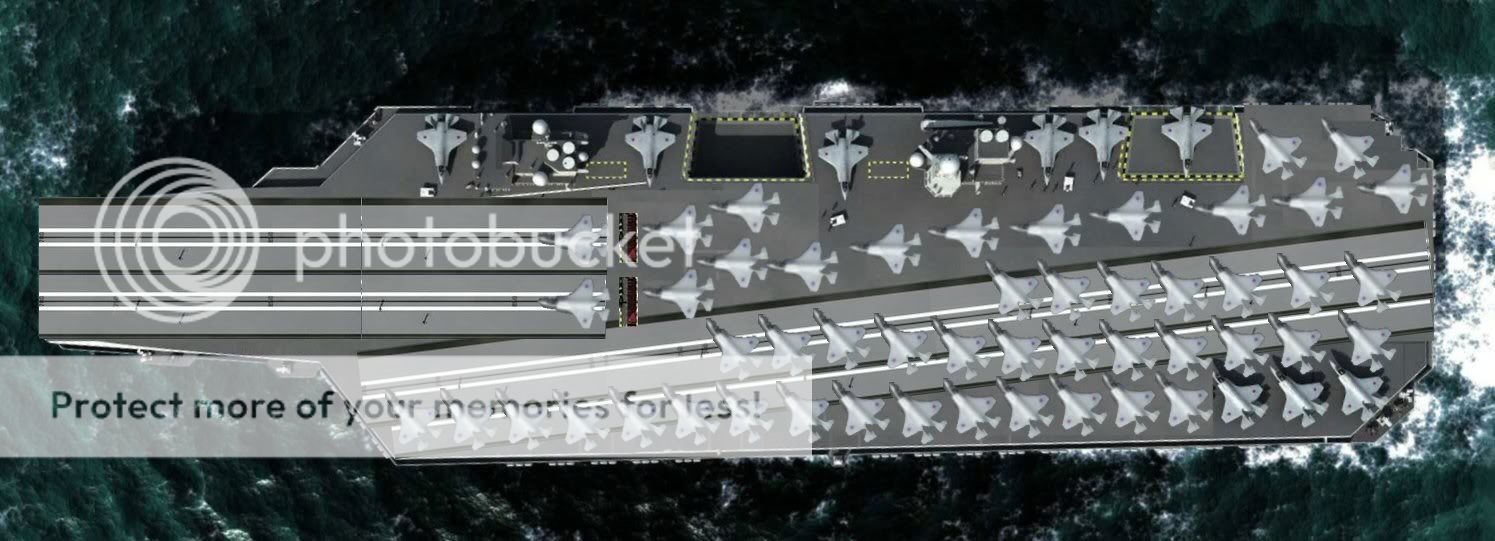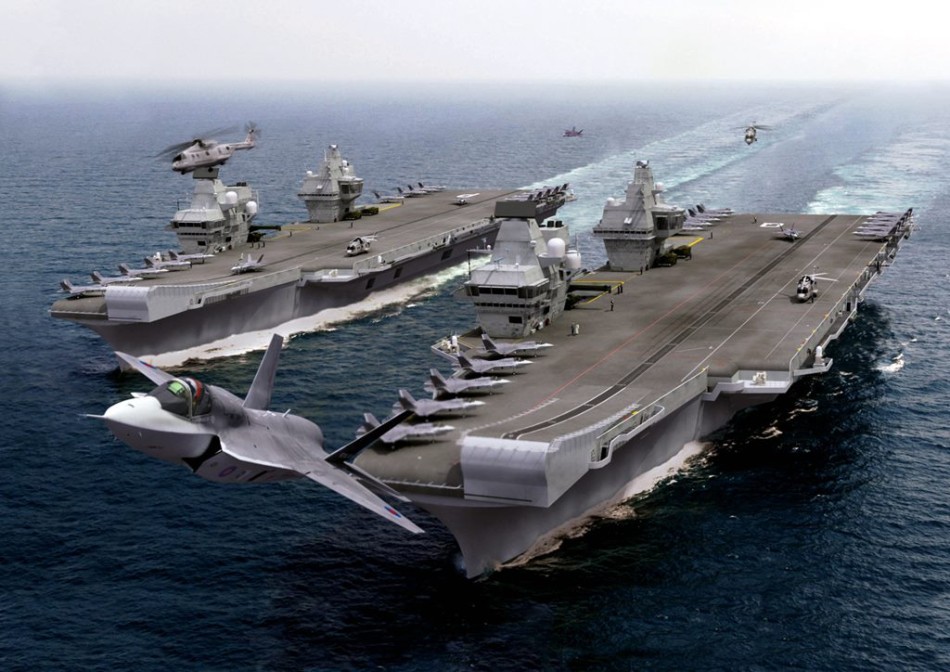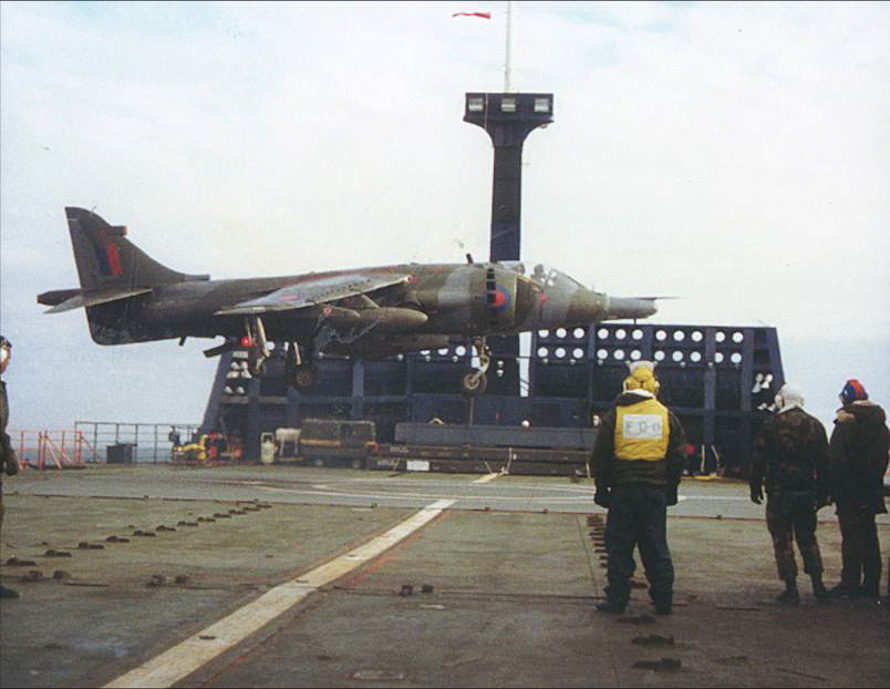Major Shaitan Singh
SENIOR MEMBER

- Joined
- Dec 7, 2010
- Messages
- 3,550
- Reaction score
- 43
- Country
- Location
The F-35 is a very controversial 5th gen stealthy fighter which is being developed by Lockheed Martin in partnership with several major European firms. Out of these firms, the British aerospace giant BAE has the second largest involvement (about 15%) along with other firms like Rolls-Royce and Martin-Baker. Their involvement has brought the F-35 program to British soil and created several thousand jobs. But how exactly is the purchase of the F-35 going to affect the Royal Air Force (RAF) and the Royal Navy (RN)? This will be examined in this article along with several alternate theories and what ifs. I won’t go into the technical aspects of the F-35, but will be doing an analysis on the logic and practicality of the aircraft in British military service.

INITIAL DREAMS
The UK has made it clear that they eventually intend to acquire 138 F-35s to augment their fleet of 160 Eurofighter Typhoons. Since the Tornado will be retired in the coming years, the Royal Air Force will be made up of 138 F-35 + 160 Eurofighter Typhoon (EFT) for a total of around 300 modern combat aircraft and the perfect mix of 4+ and 5th gen fighters. However this is an unlikely scenario as the current budget cuts in the UK is making them trim their armed forces. The budget cuts will surely affect the RAF acquisitions as well and the number of F-35s acquired could eventually end up at 72. This equates to a 50% reduction of their proposed F-35 fleet. Moreover, this number is a total of the F-35s to be operated by the RAF and the RN combined. So if 72 F-35s are procured, the RAF will likely receive only 48 and 24 would go to the RN to operate it from their future carrier fleet. So unless the defense budget of the UK magically rises and the budget cuts are stopped, the 48-24 aircraft scenario looks likely. But considering the worst possible scenario, only 48 F-35s will be procured of which 32 will be operated by the RAF and 16 by the RN. Let’s hope it doesn’t come down to that.
SITUATION CONSIDERING F-35A AND C
The F-35 term cannot be used without the proper suffix as it would be technically meaningless. There are 3 variants, the F35 A, B and C which are designed for the US Air Force, Marines and Navy respectively. For a balanced fleet, the RAF logically needs to procure the F-35A and the RN needs to procure the F-35C. Let us consider a situation where the original amount of 138 envisaged F-35s are procured. Since the RN will deploy only 1 Queen Elizabeth class carrier at a time, it needs an air wing of 32 F-35C to carry out effective operations. The RAF will end up with 106 F-35A to complement the EFT. This would make the RN and RAF extremely capable as they would be operating high performance fighters. The F-35 A and C possess long range and a large weapons load. The F-35C operating from the QE class would give the RN long range power projection ability and the capability to match the US Navy and they could carry out combat missions side by side without any shortcomings. The F-35A would be based around the UK in RAF bases and the large number of 106 jets would make up for the relatively low availability of these stealthy aircraft.

F-35C during trials

A CGI showing the actual potential of a CATOBAR Queen Elizabeth class carrier carrying F-35C Photo © Unknown via ¹
THE NEW F-35B PLAN AND ITS SHORTCOMINGS
However all this wasn’t meant to be. The RAF and RN had to agree upon a common variant to reduce procurement and operating costs. The RAF couldn’t procure the F-35C as the RNs carrier design was changed to STOVL which made the F-35B as the only option. So the RAF had to ditch the F-35A which was optimized for performance and had to switch to the F-35B which sacrificed performance (range and payload) for stealth. The RN similarly had to switch from the F-35C to the B variant and similar sacrifices were made. The RAF has a small advantage as they will operate the Short Takeoff F-35B from regular runways which will enable them to carry more payload externally.
The small internal bay is and low internal fuel capacity of the B variant is not going to be much of a problem for the US Marines. They will be getting 350+ aircraft and will have aerial tanking support from MV-22 Ospreys and KC-130s. They will also use the F-35B as an aircraft for defending their Amphibious Assault Group and to provide fire support for marines. But all this doesn’t happen more than 200-300 km from the carriers on which they are based. Each LHD of the US Navy can carry up to 30 F-35Bs if needed. Now when we equate this situation to the Royal Navy, it is clear that the Royal Navy ‘supercarriers’ will have the same power projection ability as a US Navy ‘helicopter carrier’ which displaces 20,000 tons lesser. So the point I’m trying to make is that the Royal Navy will have a very limited carrier force which could be a thorn in the future.

F-35B demonstrates VTOL capability

CGI of F-35B operating from Queen Elizabeth Class carriers
The QE class carriers were to be fitted with EMALS and arrestor gear, but the Royal budget cuts royally thwarted that dream. A former US Navy aviator told me that the RN always dreamed of a carrier and a fighter fleet which would enable them to be on par with the US Navy and operate side by side without embarrassing shortcomings. They viewed the QE class + F-35C as the answer to their prayers, but their dream wasn’t meant to be. They had to again make do with a 5th gen jump jet one and a STOVL carrier. Although the QE class + F-35B combo is no way weak, it puts them way behind the US Navy’s next gen carrier + F-35C combo. They won’t be able to conduct side by side ops on the same scale with the USN. The older Sea Harriers had massive range and payload differences compared to the USN Super Hornets. The situation will repeat again in the future, but with different aircraft.

F-35B with external weapons load
Let me make this clearer with an example. In 1982, the Sea Harriers and Harriers operating from RN carriers had a range of a few hundred km with a combat load. This meant that they couldn’t attack mainland Argentina unless they planned to not return. The Invincible class carriers and the Hermes had to be based close to the Falklands so that the Sea Harriers could provide air cover and ground fire support. If they had a CATOBAR carrier with long range fighters (like F-14 of USN and Nimitz class carriers), they could have parked their carriers 1000 km off the Falklands and carried out air superiority missions ad bombing missions with ease. The short range of their fighters and the STOVL nature of their carriers proved to be a major drawback. But more than 30 years on, the RN is keen to do the same mistake. Despite the F-35 packing state of the art sensors, the QE class carriers will have to be stationed close to enemy territory to allow the F-35B to takeoff with a decent fuel and weapons load. And since they don’t have buddy refueling capability like USN aircraft, the combat radius of the F-35B will be tiny. If they decide to trade stealth and carry external fuel tanks and weapons stores, it may make up for the short range and small payload. But a fully armed F-35B (externally and internally) cannot take off from the ski jump of the QE class itself! So they are again stuck with the same drawbacks after 30 years. If they had F-35C and buddy refueling capability, then these shortcomings would be addressed.

CGI of F-35B doing VTOL on a QE class carrier
If you know in depth about the Falkland’s war, RN based Sea Harriers on merchant ships and operated them off their decks. This allowed them to dispatch fighters from multiple and unexpected areas. This was done using vertical takeoff and landing (VTOL) which limited the amount of fuel carried and burned an immense amount of fuel during VTOL. If the RN thinks they can fly their F-35Bs off other ships with flat decks, then they are mistaken (which I’m sure they have considered). The Sea Harrier could take off from any flat piece of deck which was big enough to accommodate it. But the F-35Bs engines are so powerful, they generate an immense amount of heat which would melt unprepared or un-reinforced deck surfaces. Taking off from a destroyer deck or a merchant ship is practically impossible although theoretically it is. So even though VTOL offers a lot of flexibility, it is greatly limited as well.

Harriers and Sea Harriers on the SS Atlantic Conveyor. They took off and landed from the helipad which is visible at the aft

INITIAL DREAMS
The UK has made it clear that they eventually intend to acquire 138 F-35s to augment their fleet of 160 Eurofighter Typhoons. Since the Tornado will be retired in the coming years, the Royal Air Force will be made up of 138 F-35 + 160 Eurofighter Typhoon (EFT) for a total of around 300 modern combat aircraft and the perfect mix of 4+ and 5th gen fighters. However this is an unlikely scenario as the current budget cuts in the UK is making them trim their armed forces. The budget cuts will surely affect the RAF acquisitions as well and the number of F-35s acquired could eventually end up at 72. This equates to a 50% reduction of their proposed F-35 fleet. Moreover, this number is a total of the F-35s to be operated by the RAF and the RN combined. So if 72 F-35s are procured, the RAF will likely receive only 48 and 24 would go to the RN to operate it from their future carrier fleet. So unless the defense budget of the UK magically rises and the budget cuts are stopped, the 48-24 aircraft scenario looks likely. But considering the worst possible scenario, only 48 F-35s will be procured of which 32 will be operated by the RAF and 16 by the RN. Let’s hope it doesn’t come down to that.
SITUATION CONSIDERING F-35A AND C
The F-35 term cannot be used without the proper suffix as it would be technically meaningless. There are 3 variants, the F35 A, B and C which are designed for the US Air Force, Marines and Navy respectively. For a balanced fleet, the RAF logically needs to procure the F-35A and the RN needs to procure the F-35C. Let us consider a situation where the original amount of 138 envisaged F-35s are procured. Since the RN will deploy only 1 Queen Elizabeth class carrier at a time, it needs an air wing of 32 F-35C to carry out effective operations. The RAF will end up with 106 F-35A to complement the EFT. This would make the RN and RAF extremely capable as they would be operating high performance fighters. The F-35 A and C possess long range and a large weapons load. The F-35C operating from the QE class would give the RN long range power projection ability and the capability to match the US Navy and they could carry out combat missions side by side without any shortcomings. The F-35A would be based around the UK in RAF bases and the large number of 106 jets would make up for the relatively low availability of these stealthy aircraft.

F-35C during trials

A CGI showing the actual potential of a CATOBAR Queen Elizabeth class carrier carrying F-35C Photo © Unknown via ¹
THE NEW F-35B PLAN AND ITS SHORTCOMINGS
However all this wasn’t meant to be. The RAF and RN had to agree upon a common variant to reduce procurement and operating costs. The RAF couldn’t procure the F-35C as the RNs carrier design was changed to STOVL which made the F-35B as the only option. So the RAF had to ditch the F-35A which was optimized for performance and had to switch to the F-35B which sacrificed performance (range and payload) for stealth. The RN similarly had to switch from the F-35C to the B variant and similar sacrifices were made. The RAF has a small advantage as they will operate the Short Takeoff F-35B from regular runways which will enable them to carry more payload externally.
The small internal bay is and low internal fuel capacity of the B variant is not going to be much of a problem for the US Marines. They will be getting 350+ aircraft and will have aerial tanking support from MV-22 Ospreys and KC-130s. They will also use the F-35B as an aircraft for defending their Amphibious Assault Group and to provide fire support for marines. But all this doesn’t happen more than 200-300 km from the carriers on which they are based. Each LHD of the US Navy can carry up to 30 F-35Bs if needed. Now when we equate this situation to the Royal Navy, it is clear that the Royal Navy ‘supercarriers’ will have the same power projection ability as a US Navy ‘helicopter carrier’ which displaces 20,000 tons lesser. So the point I’m trying to make is that the Royal Navy will have a very limited carrier force which could be a thorn in the future.

F-35B demonstrates VTOL capability

CGI of F-35B operating from Queen Elizabeth Class carriers
The QE class carriers were to be fitted with EMALS and arrestor gear, but the Royal budget cuts royally thwarted that dream. A former US Navy aviator told me that the RN always dreamed of a carrier and a fighter fleet which would enable them to be on par with the US Navy and operate side by side without embarrassing shortcomings. They viewed the QE class + F-35C as the answer to their prayers, but their dream wasn’t meant to be. They had to again make do with a 5th gen jump jet one and a STOVL carrier. Although the QE class + F-35B combo is no way weak, it puts them way behind the US Navy’s next gen carrier + F-35C combo. They won’t be able to conduct side by side ops on the same scale with the USN. The older Sea Harriers had massive range and payload differences compared to the USN Super Hornets. The situation will repeat again in the future, but with different aircraft.

F-35B with external weapons load
Let me make this clearer with an example. In 1982, the Sea Harriers and Harriers operating from RN carriers had a range of a few hundred km with a combat load. This meant that they couldn’t attack mainland Argentina unless they planned to not return. The Invincible class carriers and the Hermes had to be based close to the Falklands so that the Sea Harriers could provide air cover and ground fire support. If they had a CATOBAR carrier with long range fighters (like F-14 of USN and Nimitz class carriers), they could have parked their carriers 1000 km off the Falklands and carried out air superiority missions ad bombing missions with ease. The short range of their fighters and the STOVL nature of their carriers proved to be a major drawback. But more than 30 years on, the RN is keen to do the same mistake. Despite the F-35 packing state of the art sensors, the QE class carriers will have to be stationed close to enemy territory to allow the F-35B to takeoff with a decent fuel and weapons load. And since they don’t have buddy refueling capability like USN aircraft, the combat radius of the F-35B will be tiny. If they decide to trade stealth and carry external fuel tanks and weapons stores, it may make up for the short range and small payload. But a fully armed F-35B (externally and internally) cannot take off from the ski jump of the QE class itself! So they are again stuck with the same drawbacks after 30 years. If they had F-35C and buddy refueling capability, then these shortcomings would be addressed.

CGI of F-35B doing VTOL on a QE class carrier
If you know in depth about the Falkland’s war, RN based Sea Harriers on merchant ships and operated them off their decks. This allowed them to dispatch fighters from multiple and unexpected areas. This was done using vertical takeoff and landing (VTOL) which limited the amount of fuel carried and burned an immense amount of fuel during VTOL. If the RN thinks they can fly their F-35Bs off other ships with flat decks, then they are mistaken (which I’m sure they have considered). The Sea Harrier could take off from any flat piece of deck which was big enough to accommodate it. But the F-35Bs engines are so powerful, they generate an immense amount of heat which would melt unprepared or un-reinforced deck surfaces. Taking off from a destroyer deck or a merchant ship is practically impossible although theoretically it is. So even though VTOL offers a lot of flexibility, it is greatly limited as well.

Harriers and Sea Harriers on the SS Atlantic Conveyor. They took off and landed from the helipad which is visible at the aft



